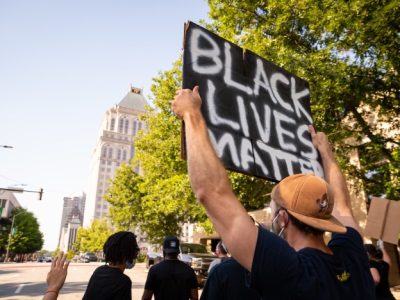History can be a dangerous thing when it viscerally connects to the current conditions of people’s lives, when it inspires people to imagine what it would mean to attain full dignity and take collective risks to manifest hope.
At least the way most of us were taught it in school, history is supposed to be safe — a continuum of dramatic episodes involving distant actors that tidily resolve themselves and have no real implications on the present.
Phyllis Bridges’ new documentary, The March on an All-American City, which premiered at High Point Theatre on Nov. 5, chronicles the local history of the civil rights movement in High Point, from official subterfuge in the 1940s to prevent blacks from using the city-owned golf course at Blair Park to the Poor People’s Campaign of 1968. Yet the framing of the film begs the question of what the history means for African Americans in High Point today, with the opening frames interspersing headlines from the 1960s with a screenshot of recent coverage of the city’s firing of its black human relations director and images from the Black Lives Matter movement.
The film’s relentless pacing, terse narration and use of strobe effects to introduce new episodes challenge the prevailing narrative of the sit-ins, and likewise resonate with the fraught atmosphere of the current moment, in contrast to the valedictory sensibility of many other civil rights documentaries. The disapproval that the demonstrators faced, even from parishioners in their own churches, brings to mind the vocal chiding received by a black protester earlier this year when she confronted Hillary Clinton about her “super-predator” comment at a fundraiser in South Carolina. The hostile and violent white mobs that greeted black students demanding service at lunch counters in Greensboro, High Point and other cities in 1960 seem not all that different from the Trump supporters attacking Black Lives Matter protesters at the candidate’s rallies over the past 12 months.
While Greensboro is rightfully recognized as the site of the sit-in that inspired the wave of activity across the South, the same drama played out in city after city, each with its own distinct leadership structures, courageous actors and sustained commitment to keep coming back day after day in the face of violent opposition.[pullquote]The film’s relentless pacing, terse narration and use of strobe effects to introduce new episodes challenge the prevailing narrative of the sit-ins, and likewise resonate with the fraught atmosphere of the current moment.[/pullquote]
In contrast to Greensboro and other cities, the backbone of the movement in High Point was high school students, most of them between 14 and 16 years old. One of them was Brenda Fountain, who had already made history as one of the first two black students, along with her sister Lynn, to desegregate all-white schools in High Point. Fountain recalls in the film that the news that four NC A&T students in Greensboro had launched a sit-in at Woolworths impelled her and her peers to action because they believed that the movement must spread to every city. “There was no black college in High Point,” Fountain says in Bridges’ film. “So we were like: ‘If not us, then who?’”
The reaction was worse than many of the students anticipated. As Mary Lou Andrews (now Mary Lou Andrews Blakeney), who would go on to serve on High Point City Council, recalls in the film, the students were kicked and punched as they left the store on the second day, and pelted with snowballs packed with shards of glass as they walked back to Washington Street.
The extensive interviews assembled by Bridges render a level of complexity missing from many accounts of the civil rights movement, which often give a one-dimensional treatment to the tactic of nonviolence. The high students underwent rigorous training in non-violence and agreed to sustain blows without responding, under the tutelage of a remarkable leader, the Rev. B. Elton Cox, who went on to serve as the national field secretary for the Congress of Racial Equality. Blakeney recalls that when her brother started to throw a punch at a white man who shoved her, Cox promptly removed him from the lunch counter. No second chances.
But Cox, who served as pastor at Pilgrim Congregational Church from 1958 to 1968, tells one interviewer: “I’m a non-violent person, but I’ve got two German Shepherds and five loaded guns to protect my home.”
The Rev. Angela Roberson, who pastors the church — now Congregational United Church of Christ — that Cox once served, explored that tension during a panel discussion after the film screening on Nov. 5. She fielded a pre-submitted question about why nonviolence was so effective, which included the opinion, “But we seem to have stepped away from that approach today.” Roberson’s response suggested that maybe the posture of Black Lives Matter is not so different from their elders.
Roberson observed that Cox “certainly was a very courageous man,” noting that he experienced multiple threats on his life and went to jail 17 times.
“So there was a way in which he conducted himself publicly as a representative of the movement,” Roberson said, “which did not negate that he would defend himself if necessary.”
Join the First Amendment Society, a membership that goes directly to funding TCB‘s newsroom.
We believe that reporting can save the world.
The TCB First Amendment Society recognizes the vital role of a free, unfettered press with a bundling of local experiences designed to build community, and unique engagements with our newsroom that will help you understand, and shape, local journalism’s critical role in uplifting the people in our cities.
All revenue goes directly into the newsroom as reporters’ salaries and freelance commissions.





Leave a Reply